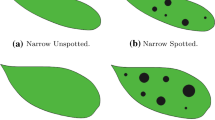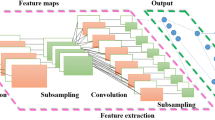Abstract
Image classification becomes a popular research area in computer vision due to the increasing development of image indexing and retrieval tasks. This paper proposes a Flower Henry Gas Solubility Optimization-based Deep Convolution Neural Network (FHGSO-based Deep CNN) for image classification. Initially, the input image is pre-processed through the median filter. Then, the segmentation is performed using the Improved Invasive Weed Flower Pollination Optimization (IIWFPO)-based SegNet. IIWFPO is the integration of the Improved invasive weed optimization (IWO) algorithm and Flower Pollination Algorithm (FPA). Finally, image classification is performed using FHGSO-based Deep CNN. The FHGSO algorithm is developed by integrating the FPA and Henry Gas Solubility Optimization (HGSO) algorithm. The performance of the proposed method is analyzed using the Stanford background dataset and compared with the other image classification methods. The proposed model obtained the value of 0.938, 0.955, and 0.907 for testing accuracy, sensitivity, and specificity, respectively.







Similar content being viewed by others
Data availability
The datasets employed in this research study are available in https://www.kaggle.com/balraj98/stanford-background-dataset.
References
Cheng HD, Sun Y (2000) A hierarchical approach to color image segmentation using homogeneity. IEEE Trans Image Process 9(12):2071–2082
Cheng HD, Jiang XH, Sun Y, Wang J (2001) Color image segmentation: advances and prospects. Pattern Recogn 34(12):2259–2281
Gauch JM, Hsia CW (1992) Comparison of three-color image segmentation algorithms in four color spaces. In: Visual communications and image Processing’92. International Society for Optics and Photonics 1818:1168–1181
Deng Y, Manjunath BS, Shin H (1999) Color image segmentation. IEEE Comput Soc Conf Comput Vis Pattern Recogn (Cat. No PR00149) 2:446–451
Santosh Kumar BP, Venkata RK (2019) An efficient hybrid optimization algorithm for image compression. Multimedia Research 2(4):1–11
Cristin R, Cyril Raj DV, Marimuthu R (2019) Face image forgery detection by weight optimized neural network model. Multimedia Research 2(2):19–27
Thomas R, Rangachar DMJS (2019) Fractional rider and multi-kernel-based spherical SVM for low resolution face recognition. Multimedia Research 2(2):35–43
Gupta P, Saxena S, Singh S, Dhami S, Singh V (2012) Color image segmentation: a state of the art survey. Int J Comput Intell Res 8(1):17–26
Guan D, Huang J, Lu S, Xiao A (2021) Scale variance minimization for unsupervised domain adaptation in image segmentation. Pattern Recogn 112:107764
Junhua C, Jing L (2012) Research on color image classification based on HSV color space. In: Second international conference on instrumentation, measurement, computer, communication and control. IEEE, pp 944–947
Kishorjit Singh N, Johny Singh N, Kanan Kumar W (2020) Image classification using SLIC superpixel and FAAGKFCM image segmentation. IET Image Process 14(3):487–494
Lei T, Jia X, Zhang Y, Liu S, Meng H, Nandi AK (2018) Superpixel-based fast fuzzy C-means clustering for color image segmentation. IEEE Trans Fuzzy Syst 27(9):1753–1766
Xing Z, Jia H (2019) Multilevel color image segmentation based on GLCM and improved salp swarm algorithm. IEEE Access 7:37672–37690
Sun L, Luo B, Liu T, Liu Y, Wei Y (2019) Algorithm of adaptive fast clustering for fish swarm color image segmentation. IEEE Access 7:178753–178762
Xing Z (2020) An improved emperor penguin optimization based multilevel thresholding for color image segmentation. Knowl-Based Syst 194:105570
Liang H, Jia H, Xing Z, Ma J, Peng X (2019) Modified grasshopper algorithm-based multilevel thresholding for color image segmentation. IEEE Access 7:11258–11295
Xu Z, Zuo S, Lam EY, Lee B, Chen N (2020) AutoSegNet: an automated neural network for image segmentation. IEEE Access 8:92452–92461
Chen CFR, Fan Q, Panda R (2021) Crossvit: Cross-attention multi-scale vision transformer for image classification. In: Proceedings of the IEEE/CVF international conference on computer vision, pp 357–366
Aranda LA, Reviriego P, Maestro JA (2017) Error detection technique for a median filter. IEEE Trans Nucl Sci 64(8):2219–2226
Badrinarayanan V, Kendall A, Cipolla R (2017) Segnet: a deep convolutional encoder-decoder architecture for image segmentation. IEEE Trans Pattern Anal Mach Intell 39(12):2481–2495
Yang XS, Karamanoglu M, He X (2014) Flower pollination algorithm: a novel approach for multiobjective optimization. Eng Optim 46(9):1222–1237
Misaghi M, Yaghoobi M (2019) Improved invasive weed optimization algorithm (IWO) based on chaos theory for optimal design of PID controller. J Comput Des Eng 6(3):284–295
Jing L, Wang T, Zhao M, Wang P (2017) An adaptive multi-sensor data fusion method based on deep convolutional neural networks for fault diagnosis of planetary gearbox. Sensors 17(2):414
Hashim FA, Houssein EH, Mabrouk MS, Al-Atabany W, Mirjalili S (2019) Henry gas solubility optimization: a novel physics-based algorithm. Futur Gener Comput Syst 101:646–667
Stanford Background Dataset taken from (2021) https://www.kaggle.com/balraj98/stanford-background-dataset. Accessed on June 2021
Faghih-Roohi S, Hajizadeh S, Núnez A, Babuska R, De Schutter B (2016) Deep convolutional neural networks for detection of rail surface defects. In: International joint conference on neural networks (IJCNN). IEEE, pp 2584–2589
Author information
Authors and Affiliations
Corresponding author
Ethics declarations
Conflict of interest
Authors do not claim conflict of interest in publishing this work.
Additional information
Publisher’s note
Springer Nature remains neutral with regard to jurisdictional claims in published maps and institutional affiliations.
Rights and permissions
About this article
Cite this article
Deepa, S.N., Rasi, D. FHGSO: Flower Henry gas solubility optimization integrated deep convolutional neural network for image classification. Appl Intell 53, 7278–7297 (2023). https://doi.org/10.1007/s10489-022-03834-4
Accepted:
Published:
Issue Date:
DOI: https://doi.org/10.1007/s10489-022-03834-4




